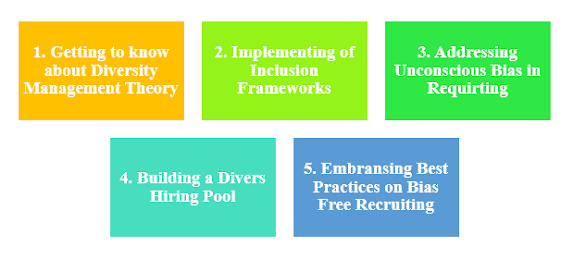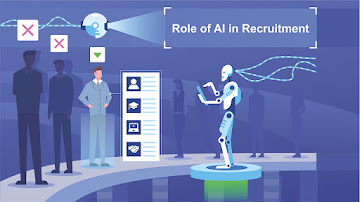Diversity and Inclusion in Recruitment for Building an Equitable Workforce
Diversity and inclusion (D&I) are considered the key principles of Human Resource Management (HRM). So, organizations are recognizing the requirements for fair and unbiased recruitment practices that may attract a wide range of talented candidates. This concept isn't just about ethics or optics; research reveals that diverse teams may more innovative, productive, and better positioned to serve global markets (Cox, 1994). Still, many companies are struggling with the implementation of genuine D&I practices that may affect superficial compliance. So, let’s talk about strategies that are used by HR professionals to encourage diversity and inclusion, ensure equitable hiring, and minimize unconscious bias by applying these strategies to relevant theories and best practices under the below points.
1. Getting to know about Diversity Management Theory (DMT)
The theory highlights the importance of recognizing and managing diverse
perspectives within an organization (Thomas, 1991). And, this theory focuses on
the need to include individuals from different backgrounds and also creating of
systems that support diverse perspectives for organizational benefits. Thomas
(1991) revealed from his research that both employee engagement and
organizational outcomes can be improved by effective diversity management and
they may help to strengthen a more inclusive culture.
Application in Recruitment: HR professionals can apply DMT to ensure
that the recruitment advertisements are inclusive and accessible to various
demographics, without any issues with language or criteria. This might
inadvertently exclude specific groups. And also this approach may highlight the
organization’s commitment to diversity
in job descriptions and promoting open, unbiased candidate selection criteria
for all candidates.
2. Implementing Inclusion Frameworks
The main focus of this framework is creating an environment that values all employees regardless of their background (Roberson, 2006). In the recruitment process, this scenario is used to translate to considering a candidate's experience. That may respect and celebrate diversity from the first interaction of the candidates.
Application in Recruitment: Organizations can use these inclusive
recruitment strategies including blind recruitment practices (candidate
identifications like name, gender, and age are removed during the initial
stages of the screening). Unconscious bias that may affect the hiring decision
can be reduced by these strategies (Bohnet, 2016). Moreover, using of diverse
and trained internal panel with D&I may also improve inclusivity in
recruitment.
3. Addressing Unconscious Bias in Recruitment
Unconscious bias is often considered the biggest challenge to fair recruitment practices of organizations. Unchecked biases can affect hiring decisions, and because of that the organizations may miss out on talented candidates from diverse backgrounds. According to Banaji and Greenwald (2013), unconscious bias is considered a cognitive shortcut that may influence the decision without conscious awareness and finally lead to potential hiring discrimination.
Application in Recruitment: The awareness of the HR and hiring teams are
much more important in this approach and they must be trained for the correct
identification and handling of unconscious bias. By using structured interviews
and asking each candidate the same or constant set of questions, fairness may
be guaranteed. Other than that, AI-powered recruitment tools can be introduced
for organizations to screen candidates objectively based on skills and
experience rather than demographic indicators. However, these AI tools must be
carefully designed to prevent the influence of algorithmic biases, which can
support rather than reduce discrimination (O’Neil, 2016).
4. Building a Diverse Hiring Pool
The inclusive recruitment process of the organizations can be stimulated by the creation of a diverse hiring pool. This may involve reaching out to underrepresented groups and expanding beyond traditional talent sources. This may include diverse communities, educational institutions, professional networks, etc.
Application in Recruitment: Organizations can use the connections with
job boards that focus on diversity and professional associations to search the
candidates with various backgrounds. And they can build partnerships with
community organizations and universities to gather applicants with a wider
range. B Further, organizations can develop internal policies including
offering flexible working conditions for the employees. This can help to gather
applicants with more accessible diverse talents such as those with different
abilities or caregiving responsibilities (Hughes & Shaheen, 2020).
5. Embracing Best Practices for Bias-Free Recruitment
The entire recruitment process can be enhanced by using best recruitment practices with reduced bias in the hiring decisions. More researchers are suggesting that using transparent and structured processes may help to ensure fair treatment for all candidates. (Koch et al., 2015).
Application in Recruitment: Organizations can develop a clear and
standardized policy for recruitment and it may help to promote the consistency
of the hiring process. HR leaders should be consistent with diverse teams and
then they can evaluate the experiences and qualifications of the candidate with
multiple perspectives.
Adopting diversity and inclusion in recruitment is a critical aspect of the
social responsibility of the organization and more than a strategic advantage.
Application of the described theories may help to embarrass inclusion
frameworks and actively counter unconscious bias. Organizations can use fair
hiring practices to build talented employees.
References
- Banaji, M. R., & Greenwald, A. G. (2013). Blindspot: Hidden Biases of Good People. New York: Delacorte Press.
- Bohnet, I. (2016). What Works: Gender Equality by Design. Harvard University Press.
- Cox, T. H. (1994). Cultural Diversity in Organizations: Theory, Research, and Practice. Berrett-Koehler Publishers.
- Hughes, J., & Shaheen, J. (2020). "Flexible Work Arrangements and Organizational Outcomes: A Meta-Analysis." Journal of Workplace Diversity, 14(1), pp. 45-67.
- Koch, A., D'Mello, S. D., & Sackett, P. R. (2015). "A Meta-Analysis of Gender Bias in Hiring: An Analysis of Stereotypes and Bias Reduction Techniques." Personnel Psychology, 68(1), pp. 55-80.
- O'Neil, C. (2016). Weapons of Math Destruction: How Big Data Increases Inequality and Threatens Democracy. Crown Publishing Group.
- Roberson, Q. M. (2006). "Disentangling the Meanings of Diversity and Inclusion in Organizations." Group & Organization Management, 31(2), pp. 212-236.
- Thomas, R. R. (1991). Beyond Race and Gender: Unleashing the Power of Your Total Workforce by Managing Diversity. AMACOM.
Do
you think HR professionals who may be responsible for the recruitment are
genuinely inclusive?
Share
your perspective in the comments and engage in the discussion on Diversity and
Inclusion in Recruitment for Building an Equitable Workforce!





Its fantastic , great job you did because breaking down complex ideas.
ReplyDeleteThank you! I'm glad you found the breakdown helpful for making complex ideas accessible is what I aimed for.
DeleteThank you so much! I'm glad the breakdown made the ideas clearer. I appreciate your feedback!
DeleteThank you so much! I'm glad the breakdown made the ideas clearer. I appreciate your feedback!
DeleteThank you so much! I'm glad the breakdown made the ideas clearer. I appreciate your feedback!
DeleteOn what basis a company measure/plan equitable workforce ?
ReplyDeleteA company can measure and plan for an equitable workforce by assessing factors like diversity representation, pay equity, opportunities for career advancement, and inclusive recruitment practices. Regular employee feedback, performance reviews, and diversity audits also help track progress and ensure fairness across all levels.
DeleteAbsolutely agree! Prioritizing diversity and inclusion in recruitment is essential for creating a more equitable and innovative workforce. Embracing varied perspectives and backgrounds not only strengthens teams but also fosters a culture where everyone feels valued and empowered to contribute."
ReplyDeleteAbsolutely! Emphasizing diversity and inclusion in recruitment brings fresh perspectives and fosters innovation. It creates an environment where every team member feels valued, which is essential for both individual growth and organizational success. It’s a win-win for everyone involved!
DeleteAbsolutely! Emphasizing diversity and inclusion in recruitment brings fresh perspectives and fosters innovation. It creates an environment where every team member feels valued, which is essential for both individual growth and organizational success. It’s a win-win for everyone involved!
DeleteThe blog thoughtfully outlines strategies to promote diversity and inclusion in recruitment, highlighting both theoretical frameworks and practical approaches. From Diversity Management Theory to unconscious bias training, these methods provide a strong foundation for organizations aiming to build an equitable workforce!
ReplyDeleteThank you! I’m glad the blog was able to effectively blend theory and practical strategies. By applying frameworks like Diversity Management Theory alongside tangible solutions like unconscious bias training, organizations can create a more inclusive and equitable recruitment process. These methods lay the groundwork for a diverse workforce that drives both innovation and positive workplace culture.
DeleteYour article effectively captures the importance of D&I in recruitment and offers actionable strategies for HR professionals to implement. Great job!
ReplyDeleteThank you so much for the kind words! I'm thrilled to hear that the article resonated with you. Promoting D&I in recruitment is such a powerful way to build stronger, more inclusive teams, and it’s great to know the strategies are helpful for HR professionals looking to make an impact.
DeleteFor your question, I think many HR professionals challange some biases. For that I think concontinuous trainings are required.
ReplyDeleteI agree that challenging biases is a key aspect of improving HR practices, but I believe that while continuous training is essential, it alone may not be enough to fully eliminate biases. Training programs are effective in raising awareness and providing HR professionals with tools to recognize and address biases, but without a broader systemic approach, biases can still manifest unconsciously during recruitment or decision-making processes.
DeleteTo truly combat bias, organizations should implement structured and transparent recruitment processes, such as standardized interviews and diverse hiring panels, which can help minimize the influence of individual biases. Additionally, adopting data-driven recruitment strategies, like blind recruitment or using AI tools to assess candidates based on skills and qualifications, can further reduce subjectivity.
In combination with continuous training, these strategies can create a more equitable hiring environment, ultimately leading to a more diverse and inclusive workforce. It’s about making bias mitigation a core part of the company culture, not just a checkbox to tick through training.
Prioritizing diversity and inclusion in recruitment is essential for building an equitable workforce. Inclusive hiring practices attract a broader range of talent, foster innovation, and reflect a commitment to fairness. By reducing bias and promoting equal opportunities, organizations can create a more dynamic and representative team environment.
ReplyDeleteWell said! Prioritizing diversity and inclusion truly strengthens teams, drives innovation, and shows a commitment to fairness. It’s a crucial step toward a more dynamic and balanced workforce.
DeleteYour insights are a breath of fresh air!
ReplyDelete